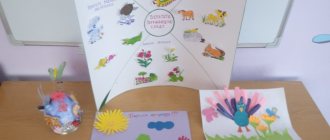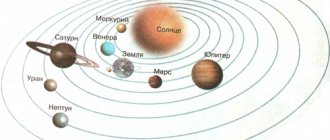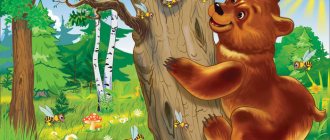Junior group. Early childhood, nursery. Children 1-4 years old
Summary of a lesson on the use of health-saving technologies with children 3–4 years old If there is health, a person is happy , lives peacefully, works, studies, goes to kindergarten. Without health you cannot live , you cannot love, you cannot be beautiful, charming. The first steps to health , the desire for a healthy lifestyle , to self-knowledge, the formation of a culture of health .
Abstract of the educational standard for a healthy lifestyle “I want to be healthy” (junior group) Abstract of the educational standard for a healthy lifestyle : “
I want to be healthy ” (junior group)
Goal: to develop in children the foundations
a healthy lifestyle , the need to maintain their health . Objectives: to form in children primary knowledge about a healthy lifestyle ; evoke a desire to take care of your health ;.
Abstract of educational activities on cognitive development on the topic “Healthy”
Complex lesson “The Secret of Health” in 1st junior group.
Goal: To form an idea of health, to highlight the rules of cultural and hygienic behavior.
Tasks:
1. To strengthen children’s knowledge about a healthy lifestyle;
2. To consolidate the acquired knowledge about the importance of vitamins, the names of vegetables and fruits, hygiene skills;
3.Develop jumping ability, dexterity in a playful way, improve coordination of movements;
Developmental environment: Aibolit doll, fake vegetables and fruits, two plates.
Progress of the lesson
1.Organizing moment
The teacher gathers the children and informs them that Aibolit has arrived at the kindergarten, he is visiting the groups and checking the children’s health, and will now come to them. There is a knock on the door, the teacher brings in an Aibolit doll.
The teacher meets the guest, acts out the dialogue and actions with him.
Aibolit - Hello, children, I came to see you - how are you after winter, are you healthy. I want to tell you about the secrets of health. Health must be protected. So I ask you: how do you take care of your health? What do you do to avoid getting sick? Why are you silent? Do not know?
Educator - They know that health is exercise, rosy cheeks, this is when we are strong, dexterous, brave and cheerful, this is when we are friends with vitamins.
Aibolit - Correct. ( Children
) Have any of you taken vitamins? Vitamins make our body strong and healthy, resistant to disease. But vitamins come not only in tablets, they also grow on branches. Many vitamins are found in fruits and vegetables.
Educator - The guys and I know that fruits grow on branches and vegetables in the garden.
Aibolit - Today I brought you fruits and vegetables, but all the vegetables and fruits are mixed, who will help me find the fruits?
2.Game “Fruits and vegetables”
Children put fruits and vegetables on different plates.
Aibolit - I’ll tell you a secret, to be healthy, you need not only to eat vitamins and be strong!
You definitely need to wash
Morning, evening and afternoon -
Before every meal
After sleep and before bed!
What if you have a child who doesn’t really know how to wash himself?
Educator - I’m sure that we don’t have such children, dear Aibolit.
Aibolit - How can I check this? I came up with an idea, you guys should answer my questions.
- You decide to wash your face. What is needed for this? ( Water, soap, towel.)
- How to open a water tap correctly? So that the splashes fly in all directions? ( No, the tap must be opened so that the water flows in a small stream.)
- What should you do first before going to the water tap? ( Roll up your sleeves to avoid getting your shirt or dress wet.)
Educator - Show how to roll up your sleeves. Like this. (Children show movements.)
The sleeves were rolled up, the tap was turned on, and water flowed in a thin stream. Now we will show you how to wash your hands. Like this, in a circular motion, as if one palm is stroking the other.
- First you need to wet your hands with water, soap them and rub one against the other to create foam - real white gloves. And after that you need to wash off the soap with water.
- After you have washed the soap off your palms, what should you do? (Wipe them with a towel.)
- How should you properly dry your hands with a towel? (Each finger separately.)
Educator - All that remains is to turn off the tap and hang the towel in place.
Aibolit - Yes, indeed, all children know how to wash themselves properly. Well, we can only praise them for this.
– Here, I look at the guys: They don’t slouch, they sit. Everyone is washed, everyone is neat, and, probably, neat?
Educator - Let's tell Aibolit how to sit on a chair correctly during classes and at the table?
Children answer: the backs should be straight, the legs should be under the chair, and the hands should be folded at the table in front of the chest.
Educator: What is this for?
Children: So that our backs are straight and beautiful.
Aibolit - Guys, do you know how to behave while eating?
Children's answers
Why do you need to behave this way at the table?
Children's answers: to avoid choking while eating.
Educator - So, do they hold the spoons carefully? Do they eat everything quickly and in unison? Don't they throw crusts on the floor? No tea is spilled on the table
Because they know for sure:
(with children)
“He who eats beautifully looks happy.” “When I eat, I am deaf and dumb”
Aibolit - Well, you have learned my health secrets!
I think it's for the guys
There is no more pleasant activity than picking your nose. Everyone is terribly interested in what is hidden inside. And whoever is disgusted to look, let him not look.
Educator - Something, Aibolit, you are confusing. Guys, is it possible to touch your nose and pick it?
Children's answers.
Educator - Every small child knows that picking your nose is ugly and indecent, you can hurt your nose and it will bleed. Our children know that this is dangerous to their health. It's good for your health to move a lot, let's dance with you.
3.Dance “Boogie-Woogie”
Educator - Aibolit, I know another secret of health, you need to do only good things and not do anything bad. Then you will be beautiful and healthy!
Aibolit - Do you guys know what is good and what is bad?
Educator - Now Aibolit we will tell you about it. If I say that I’m doing something good, you add: “Me too”: if it’s bad, keep quiet, don’t say anything, agreed? Remember. Begin. Just be careful!
4. Game “Me too”
- I know how to eat carefully.
- I don't listen to my elders.
- I'm friends with the guys.
- I'm behaving well!
- I'm walking outside!
- I hate all the guys!
If someone made a mistake and said: “Me too,” Aibolit says: “Who said “Me too”? Let me look at the children who offend their friends!.. What?.. You’re not offending, you just made a mistake? It’s good, we need to be friendly!”
Aibolit - The most important secret of health, you need to play sports and do exercises every morning.
5. Physical education lesson ( conducted by the teacher, together with Aibolit )
Hey guys, pull yourself up
Don't yawn and don't be lazy,
Get ready to exercise!
One, two, three, we started spinning, We turned into bear cubs. Now the cubs will do their exercises.
Sipping:
In the morning, little bear woke up. Little bear reached out to the sun. Like this, like this, Mishka reached out to the sun.
Turns:
The cubs lived in the thicket and turned their heads. Like this, like this. They turned their heads
Tilts:
The cubs were looking for honey, They rocked the tree together, Like this, like this, They rocked the tree together. Squat: We waddled around and drank water from the river. Like this, like this And they drank water from the river.
Jumping:
Bears have fun playing. The bears want to jump. One, two; one, two, the game is over.
Stop! Charging has ended. Inhale and exhale for order. One, two, three - we started spinning and turned into kids.
Aibolit - I have prepared a surprise for all of you guys. Today you will receive a glass of vitamin juice from me in order to grow strong and healthy. And before I leave, I want to play with you.
6.Acupressure from Aibolit
Come to me, my friend, and quickly sit in the circle. Find your ears and show them quickly. And then, and then, They twisted the trestle. The ear seems to be frozen, this is how you can warm it up. We play cleverly with them, flapping our ears like this. And now we are pulling everything down. Ear, don't fall off! One, two! One, two! So the game is over. And once the game ended, it was quiet!
7. Summary
Educator - Guys, it’s time for Aibolit to go to another group, let’s say thank you to him for telling us about the secrets of health. And now we will try to remember what you need to do to be healthy.
- Do exercises;
- Eat vitamins;
- Wash your hands before eating;
- Behave politely at the table.
Lesson summary for the second junior group on the topic: Healthy lifestyle
Lesson notes for the second junior group.
Topic: “Let’s teach Mishutka to take care of his health”
Integration of educational areas: “Cognition”, “Communication”, “Socialization”, “Health”, “Artistic creativity”.
Author: teacher Elizarova Irina Stanislavovna, MB pre-school educational institution CRR DS “Zvezdochka”, Kondopoga. Program content: 1. To consolidate ideas about acceptable children’s understanding of ways to strengthen and maintain health (morning exercises, walks in the fresh air, eating vegetables and fruits, vitamins). 2. Continue to lead children to the ability to understand object models. 3. Exercise in distinguishing some vegetables (garlic) and fruits (apple) with the participation of analyzers (smell and taste). 4. Contribute to the activation of children’s vocabulary through the use of words - different parts of speech; develop dialogical forms of speech (understanding of addressed speech, answers to asked questions). 5. Strengthen the skill of drawing with a “poke” (“vitamins”), placing the image over the entire silhouette. 6. Foster a desire to take care of your health and the health of others. Materials for the lesson: Toy Bear (bibabo), screen, cup and saucer, honey, spoon, subject pictures: “morning exercises”, “walk”, head of garlic, apple, plate, napkins, jar “for the smell of garlic”, toothpicks number of children for pieces of apples, a jar of vitamins, object models;
Equipment for painting: pokes, stands, gouache, oilcloth, napkins, silhouettes of jars, paint plates. Progress of the lesson:
1. Organizational moment: “All the children gathered in a circle. I am your friend and you are my friend. Let’s hold hands tightly and smile at each other” 2. Game technique: a little bear cub is grunting behind the screen V.: Who could it be? (a bear cub appears from behind the screen). Hello, Mishutka! It's so good that you came to us. M.: (coughs) - Hello, guys! V.: Mishutka, will you sing us a funny song or play a game? M.: No, I don’t want to (coughs) V.: Guys, what happened to Mishutka, what do you think? (children's assumptions). Mishutka caught a cold. Drink Mishutka tea with honey, and the cough will quickly go away (we serve a cup, Mishutka “drinks”). M.: Thank you! Q: Guys, why do you think Mishutka got sick? (children's assumptions). Mishutka, do you know how to take care of your health? (Mishutka shakes his head). Then listen and watch carefully. The guys and I will tell you and show you what you need to do to avoid getting sick. 3. A story about ways to strengthen and maintain health. V.: (the teacher turns the children to the picture) Look carefully and tell me what the girl is doing? (the girl does exercises). What about you and I, when do we exercise? (in the morning, when we arrive at kindergarten). Shall we show Mishutka our exercises? Come out to me, stand comfortably so as not to disturb each other. Physical education minute. Every day we do exercises in the morning. We really like to do everything in order (they go on the spot). Raise your arms, lower your arms, squat and stand, jump and gallop (movements according to the text) - repeat 2 times. V.: Well done! Guys, so that both you and Mishutka can better remember what is good for your health, I will place picture tips on the board. Do you agree? (show the model to the children).
To be healthy, you need to do exercises in the morning (we hang the model on the board). V.: (we invite the children to go to the next picture) Who are drawn in this picture? (children). What are boys and girls doing? (play, walk on the street). You and I also go for a walk every day. What do we do on a walk (children’s answers) - picture prompt on the board.
V.: And we also breathe fresh air while walking. What do we breathe? (nose). Let's show Mishutka how to breathe correctly: close her mouth, inhale through her nose, exhale. and to make your nose breathe better, this exercise is useful: breathe through one nostril, then the other (breathing exercises, repeat 2 times). Well done! And the nose can distinguish different smells. Let's try to guess the smell of one health secret? (the teacher quietly takes a jar with the smell of garlic, the children sniff). Can you guess what it is? That's right, it's garlic. Mishutka. Shall we give it a sniff? (Mishutka sniffs, brrr, shakes his head). Mishutka, garlic is a very healthy vegetable (opens a napkin and there is a head of garlic on the plate). Guys, tell Mishutka why you need to eat garlic? (children's answers). That's right, garlic is good for health - picture hint for the board.
The teacher invites the children to sit on chairs. Q: Guys, tell me, are fruits good for health? (children's answers). What fruits do you know? (children's answers). I also have fruit on my plate, try to guess what it tastes like? Just let’s give Mishutka a try first. Help yourself, Mishutka, please (the little bear tries it and smacks his lips). V.: Have you guessed, Mishenka, what kind of fruit it is? (Mishutka shakes his head). Now let the guys try to guess. Close your eyes, open your mouth (the teacher gives the children a piece of apple). Can you guess what kind of fruit this is? (children's answers). An apple is a fruit, and fruits are very healthy, they contain a lot of vitamins - picture hint for the board.
The teacher shows the children a jar of vitamins. Q: What do you guys think is in this jar? (children's answers). That's right, vitamins. They are good for health. We take one vitamin every day. Maybe we can give Mishutka some vitamins? (speaks and opens the jar). But there are very few of them here? (shows it to the children or pours it onto a plate). What do we do? (children's assumptions). Maybe we can draw some vitamins for Mishutka? (children's answers). The children agree, the teacher suggests approaching the tables. 4. Preparation for drawing, productive activity of children. V.: Look, there are jars on the tables. We will draw vitamins on them. What are we going to draw with? (poking). Take the poke. Let's first try to draw vitamins without paint (comment: the poke is jumping like a ball, we'll draw all over the jar). Now dip the poke in the paint and draw vitamins (while working, you can ask the children what color are the vitamins? What shape are they? Remind them that they need to draw vitamins all over the jar, there should be a lot of them). V.: Take the jars and take them to Mishutka (children place the drawings on the table in front of the screen). Well done, guys, how many jars of vitamins Mishutka now has - a picture hint for the board.
5. Analysis of the lesson. Q: What did we teach Mishutki today? (children's answers: take care of your health so as not to get sick). Let us repeat once again for Mishutka what needs to be done (according to the models - do exercises, walk more in the fresh air, eat garlic and fruits, take vitamins - one per day). V.: Do you remember, Mishutka? M.: Thanks, guys! I will try to follow your advice so as not to get sick and I will tell all my forest friends. It's time for me to leave, goodbye guys! (hides behind the screen). D.: Goodbye, Mishutka. V.: Be healthy, you guys too. Well done to you all today! Let's clap our hands and praise ourselves.
We recommend watching:
Summary of an integrated lesson in the younger group. Fair Lesson notes for the junior group: Trees in the snow GCD cognition in the junior group of kindergarten. Cultural and hygienic skills Summary of OOD on social and communicative development in the junior group
Similar articles:
Summary of GCD in the 2nd junior group on the topic: Autumn



